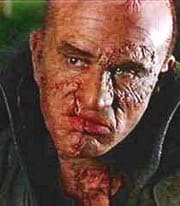Frankenstein
Critique • Text • Frankenstein at the movies
 Frontispiece, first illustrated edition 1831
Frontispiece, first illustrated edition 1831Original title
Frankenstein; or, The Modern Prometheus
First publication
1818
Literary form
Novel
Genre
Literary, science fiction, horror
Writing language
English
Author's country
England
Length
Approx. 78,000 words

Kenneth Branagh goes overboard as Frankenstein in his lab. (Robert De Niro is under the sheet.)
A lost soul
Mary Shelley's Frankenstein (1994): Film, 123 minutes; director Kenneth Branagh; writers Steph Lady, Frank Darabont; featuring Robert De Niro, Kenneth Branagh, Tom Hulce, Helena Bonham Carter
Dozens more Frankensteins appeared in the second half of the twentieth century, but the one that's received the most attention is Kenneth Branagh's opus, Mary Shelley's Frankenstein (1994).
Beware films that carry the author's name in the title. They're trying to tell you they, unlike others, are presenting the real stories, faithfully to the original literary works. But this is seldom true. And when it is true, it's often a bad decision cinematically.
Yes, this film follows Shelley's story somewhat accurately, including that Arctic chase enclosing the tale. But it's so grandiose and melodramatic. Shelley's novel is related rather matter-of-factly, which makes the horror all the more effective. But in Branagh's film the big romantic gestures and special effects pretty soon tire you out.
By the time the monster appears, he's an anticlimax. We discover the monster is rather a non-entity. Robert De Niro may be one of our greatest actors but his method approach drains all the juice from the main role here. He just looks like someone who's been in a bad car accident.
And he acts like a petty criminal with a screw loose, the kind of lost souls you see on the streets of big cities every day.
This is Frankenstein's monster as a human sociopath, rather than as the ungodly creature of Shelley's conception. This is a "monster" in social, not metaphysical, terms.
Okay, what's wrong with translating a classic into terms to be better understood by our own times? Nothing, if it's believable for our times.
I like the creation of the monster by Frankenstein (Branagh) through chemical processes, closer to the procedure in Shelley's novel, rather than through harnessing the power from lightning strikes as in the old films. It does go overboard though with this set. Frankenstein's private lab is much larger and more elaborate than could be hidden in the medical student's nineteenth-century apartment.
Other incredible elements of the original plot—such as having the monster learn to speak and read by observing others—are also retained, throwing realism further out the window.
The film is worth viewing as an attempt to make a Frankenstein that is faithful to the original novel—more so than any film before—while recasting it in a more modern mould. But ultimately it dissatisfies on both counts.
Worse, while we have to admire the acting, the sincere script, and the cinematic art that went into Mary Shelley's Frankenstein, we are not moved. By the monster, nor by his creator.
— Eric
Critique • Text • Frankenstein at the movies
1931, 1935, 1939, 1942–1948, 1957, 1958–1970, 1973–1996, 1994, 2014


